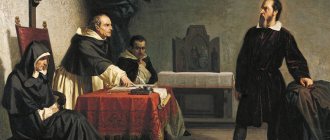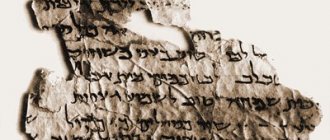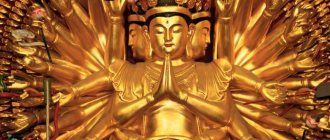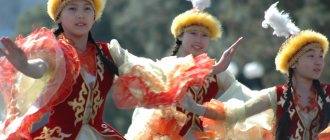Patriarch Nikon (in the world Nikita Minin 1605-1681) ascended the Moscow patriarchal throne in 1652. Even before his elevation to patriarch, he became close to Tsar Alexei Mikhailovich. Together they decided to remake the Russian church in a new way: to introduce new rites, rituals, and books into it, so that it would be in everything like the Greek church, which had long ceased to be completely pious.
Proud and proud, Patriarch Nikon did not have much education. Nikon came from a peasant family from the Nizhny Novgorod region. Being already an abbot, he met with Alexei Mikhailovich, made a strong impression on the pious Tsar, he insisted that Nikon move to Moscow.
Nikon, he surrounded himself with learned Ukrainians and Greeks, of whom Arseny the Greek, a man of very dubious faith, began to play the largest role. Arseny received his upbringing and education from the Jesuits; upon arrival in the East, he converted to Mohammedanism, then again joined Orthodoxy, and then turned to Catholicism. When he appeared in Moscow, he was sent to the Solovetsky Monastery as a dangerous heretic. From here Nikon took him to him and immediately made him his main assistant in church affairs. This caused great temptation and murmur among the believing Russian people.
But it was impossible to object to Nikon. The king granted him unlimited rights in church affairs. Nikon, encouraged by the king, did what he wanted, without consulting anyone. Relying on friendship and royal power, he embarked on church reform decisively and boldly.
Reforms of Patriarch Nikon
Patriarch Nikon began to introduce new rituals, new liturgical books and other innovations into the Russian Church without the approval of the council, without permission. This was the reason for the church schism. People began to call those who followed Nikon “Nikonians,” or New Believers.
Nikon’s followers themselves, using state power and force, proclaimed their church Orthodox, or dominant, and began to call their opponents the offensive and fundamentally incorrect nickname “schismatics.” They blamed the church schism on them. In fact, the opponents of Nikon’s innovations did not commit any schism: they remained faithful to the ancient church traditions and rituals, without changing their native Orthodox Church in any way. Therefore, they rightly call themselves Orthodox Old Believers, Old Believers or Old Orthodox Christians.
The most important changes and innovations were the following:
- Instead of the two-fingered sign of the cross, which was adopted in Rus' from the Greek Orthodox Church along with Christianity and which is part of the Holy Apostolic tradition, three fingers were introduced.
- In old books, in accordance with the spirit of the Slavic language, the name of the Savior “Jesus” was always written and pronounced; in new books this name was changed to the Greekized “Jesus”.
- In old books, it is established during baptism, wedding and consecration of the temple to walk around the sun as a sign that we are following the Sun-Christ. In the new books, walking against the sun has been introduced.
- In the old books, in the Creed (VIII clause), it reads: “And in the Holy Spirit of the true and life-giving Lord,” but after corrections the word “true” was excluded.
- Instead of the “pure”, i.e., double hallelujah, which the Russian Church has performed since ancient times, a “triple” (triple) hallelujah was introduced.
- The Divine Liturgy in Ancient Rus' was celebrated in seven prosphoras, the new “spravshchiki” introduced five prosphoras, that is, two prosphoras were excluded.
The above examples show that Nikon and his assistants boldly attempted to change church institutions, customs and even the apostolic traditions of the Russian Orthodox Church, adopted from the Greek Church at the baptism of Rus'.
Activities of the Old Believers
Thus, Nikon's reforms were rejected by a significant number of believers, whose protest resulted in a religious war. The Old Believers were persecuted, the government persecuted them, and they sought salvation in remote corners of the Russian State. In response to church policy, the Old Believers staged mass self-immolations, which were called burnings.
Historical literature often characterizes the church schism as the starting point of massive popular unrest that periodically engulfed Russian lands in the 17th and 18th centuries. In fact, the Old Believers gained strong support from ordinary people; those who were dissatisfied with the existing order in the country gathered around them.
What did Nikon really do?
Upon assuming his patriarchal duties, Nikon enlisted the tsar's support not to interfere in the affairs of the Church. The king and the people pledged to fulfill this will, and it was fulfilled. Only the people weren’t actually asked; the people’s opinion was expressed by the tsar (Alexey Mikhailovich Romanov) and the court boyars. Almost everyone knows what the notorious church reform of the 1650s - 1660s resulted in, but the version of the reforms that is presented to the masses does not reflect its entire essence.
The true goals of Nikon's reform are hidden from the unenlightened minds of the Russian people. A people who have been robbed of the true memory of their great past and trampled upon all their heritage have no choice but to believe in what is handed to them on a silver platter. It’s just time to remove the rotten apples from this platter and open people’s eyes to what really happened.
The official version of Nikon’s church reforms not only does not reflect its true goals, but also presents Patriarch Nikon as the instigator and executor, although Nikon was just a “pawn” in the skillful hands of the puppeteers who stood not only behind him, but also behind Tsar Alexei Mikhailovich himself .
And what’s also interesting is that despite the fact that some churchmen blaspheme Nikon as a reformer, the changes that he made continue to operate to this day in the same church! That's double standards!
Let's now see what kind of reform this was
The main reform innovations according to the official version of historians: The so-called “book right”, which consisted of rewriting liturgical books. Many textual changes were made to the liturgical books, for example, the word “Iesus” was replaced with “Jesus.” The two-finger sign of the cross has been replaced by the three-finger one. Prostrations have been cancelled. Religious processions began to be carried out in the opposite direction (not salting, but counter-salting, i.e. against the sun). I tried to introduce a 4-pointed cross and succeeded for a short period of time.
Researchers cite many reform changes, but the above are especially highlighted by everyone who studies the topic of reforms and transformations during the reign of Patriarch Nikon.
As for the “book right”. During the baptism of Rus' at the end of the 10th century. The Greeks had two charters: Studite and Jerusalem. In Constantinople, the Charter of the Studios was first widespread, which was passed on to Rus'. But the Jerusalem Charter, which by the beginning of the 14th century began to become increasingly widespread in Byzantium. ubiquitous there. In this regard, over the course of three centuries, the liturgical books there also changed imperceptibly. This was one of the reasons for the difference in the liturgical practices of Russians and Greeks. In the 14th century, the difference between Russian and Greek church rites was already very noticeable, although Russian liturgical books were quite consistent with the Greek books of the 10th-11th centuries. Those. There was no need to rewrite the books at all! In addition, Nikon decided to rewrite books from Greek and ancient Russian charateans. How did it really turn out?
Replacement of double-fingered with triple-fingered
Double-fingered baptism existed in Rus' from time immemorial, even before it adopted Christianity. Before the battle, the warriors touched with two fingers first the left shoulder, then the right, and then the middle of the forehead, saying: “For honor! For conscience! For faith! It was this ritual that was adopted by the Christian church and transformed into the familiar sign of the cross. Two fingers making the sign of the cross symbolize the two natures in Christ - Divine and human, and reflect the true dogma of the Creed - the crucifixion and resurrection of Christ.
Three fingers is a New Believer tradition that does not carry any historical justification. By crossing themselves with three fingers, believers mean the Holy Trinity, and thereby mislead themselves, since only “one of the Holy Trinity, the Son of God” was crucified on the cross.
What was Nikon looking for in the people?
But in fact, the cellarer of the Trinity-Sergius Lavra, Arseny Sukhanov, is sent by Nikon to the East specifically for sources for the “right”, and instead of these sources he brings mainly manuscripts “not related to the correction of liturgical books” (books for home reading, for example , words and conversations of John Chrysostom, conversations of Macarius of Egypt, ascetic words of Basil the Great, works of John Climacus, patericon, etc.). Among these 498 manuscripts there were also about 50 manuscripts even of non-ecclesiastical writing, for example, the works of Hellenic philosophers - Troy, Afilistrate, Phocleas “on sea animals”, Stavron the philosopher “on earthquakes, etc.).
Doesn't this mean that Arseny Sukhanov was sent by Nikon to look for “sources” to divert attention? Sukhanov traveled from October 1653 to February 22, 1655, that is, almost a year and a half, and brought only seven manuscripts for editing church books - a serious expedition with frivolous results.
“Systematic Description of Greek Manuscripts of the Moscow Synodal Library” fully confirms the information about only seven manuscripts brought by Arseny Sukhanov. Finally, Sukhanov, of course, could not, at his own peril and risk, obtain works of pagan philosophers, manuscripts about earthquakes and sea animals far away, instead of the necessary sources for correcting liturgical books. Consequently, he had the appropriate instructions from Nikon for this...
And again we learn about rewriting books
But in the end it turned out even more “interesting” - the books were copied from new Greek books, which were printed in Jesuit Parisian and Venetian printing houses. The question of why Nikon needed the books of “ pagans ” (although it would be more correct to say Slavic Vedic books, not pagan ones) and ancient Russian charatean books remains open.
But it was with the church reform of Patriarch Nikon that the Great Book Burn in Rus' began, when entire carts of books were dumped into huge bonfires, doused with resin and set on fire. And those who resisted the “book law” and reform in general were sent there! The Inquisition, carried out in Rus' by Nikon, did not spare anyone: boyars, peasants, and church dignitaries were sent to the fires.
Well, during the time of Peter I, the Great Book Garb gained such power that at the moment the Russian people do not have almost a single original document, chronicle, manuscript, or book left. Peter I continued Nikon's work in erasing the memory of the Russian people on a wide scale. Siberian Old Believers have a legend that under Peter I, so many old printed books were burned at the same time that after that 40 pounds (equivalent to 655 kg!) of melted copper fasteners were raked out of the fire pits.
During Nikon’s reforms, not only books, but also people burned. The Inquisition marched not only across the expanses of Europe, and, unfortunately, it affected Rus' no less. Russian people were subjected to cruel persecution and execution, whose conscience could not agree with church innovations and distortions. Many preferred to die rather than betray the faith of their fathers and grandfathers. The faith is Orthodox, not Christian. The word Orthodox has nothing to do with the church! Orthodoxy means Glory and Rule. Rule - the world of the Gods, or the worldview taught by the Gods (Gods used to be called people who had achieved certain abilities and reached the level of creation. In other words, they were simply highly developed people).
Nikon created the Russian Orthodox Church
The Russian Orthodox Church received its name after the reforms of Nikon, who realized that it was not possible to defeat the native faith of the Rus, all that remained was to try to assimilate it with Christianity. The correct name of the Russian Orthodox Church MP in the outside world is “Orthodox Autocephalous Church of the Byzantine sense.”
Until the 16th century, even in Russian Christian chronicles you will not find the term “Orthodoxy” in relation to the Christian religion. In relation to the concept of “faith”, such epithets as “God’s”, “true”, “Christian”, “right” and “immaculate” are used. And even now you will never come across this name in foreign texts, since the Byzantine Christian church is called - orthodox, and is translated into Russian - correct teaching (in defiance of all the other “wrong” ones).
Orthodoxy - (from the Greek orthos - straight, correct and doxa - opinion), a “correct” system of views, fixed by the authoritative authorities of a religious community and mandatory for all members of this community; orthodoxy, agreement with the teachings preached by the church. Orthodox refers primarily to the church in Middle Eastern countries (for example, the Greek Orthodox Church, Orthodox Islam, or Orthodox Judaism). Unconditional adherence to some teaching, firm consistency in views. The opposite of orthodoxy is heterodoxy and heresies.
Never and nowhere in other languages will you be able to find the term “Orthodoxy” in relation to the Greek (Byzantine) religious form. The substitution of imagery terms for an external aggressive form was necessary because THEIR images did not work on our Russian soil, so we had to mimic existing familiar images.
The term “paganism” means “other languages.” This term previously served the Russians simply to identify people speaking other languages.
Changing the two-finger sign of the cross to the three-finger one
Why did Nikon decide to make such an “important” change in the ritual? For even the Greek clergy admitted that nowhere, in any source, is it written about baptism with three fingers!
Regarding the fact that the Greeks previously had two fingers, the historian N. Kapterev provides undeniable historical evidence in his book “Patriarch Nikon and his opponents in the matter of correcting church books.” For this book and others
Results of the split
They can be briefly characterized as follows.
- The church schism of the 17th century grew into a national tragedy. The Russian people were divided into those who remained in the bosom of the Orthodox Church, who performed divine services according to the new canons, and the Old Believers, who adhered to the pre-reform rules.
- As a result of the schism, the spiritual unity of the Russian people was destroyed. For the first time in the history of the country, hostility on religious grounds arose.
- Priority was established over ecclesiastical power over secular power. The reform process was initiated by the tsarist government and took place with its full support. This was the beginning of the transition of the management of church affairs to state institutions. The completion of this process already occurred under Peter the Great, who abolished the patriarchate.
- The international position of the Russian state and its connections with the countries of the Orthodox world have noticeably strengthened.
- The Old Believers movement influenced the development of Russian art, making its own contribution to it. Spiritual centers and their own school of icon painting were created, and the ancient Russian traditions of writing books and znamenny singing were preserved.
In conclusion, let us consider the change in the views of the Russian Orthodox Church on the Old Believers.
Changes in architecture
The “church” reforms of the mid-17th century were directly related to religious construction. The order to strictly follow the Byzantine canons put forward the requirement to build churches “with five peaks, and not with a tent.”
Tent-roofed buildings (with a pyramidal top) were known in Rus' even before the adoption of Christianity. This type of building is considered originally Russian. That is why Nikon, with his reforms, took care of such “trifles”, because this was a real “pagan” trace among the people. Under the threat of the death penalty, craftsmen and architects managed to preserve the shape of the tent in temple buildings and secular ones. Despite the fact that it was necessary to build domes with onion-shaped domes, the general shape of the structure was made pyramidal. But not everywhere it was possible to deceive the reformers. These were mainly the northern and remote areas of the country.
Since then, churches have been built with domes; now, thanks to the efforts of Nikon, the tented form of buildings has been completely forgotten. But our distant ancestors perfectly understood the laws of physics and the influence of the shape of objects on space, and it was not without reason that they built with a tent top.
This is how Nikon cut off the people’s memory.
Also in wooden churches the role of the refectory is changing, turning from a room that is secular in its own way into a purely cultic one. She finally loses her independence and becomes part of the church premises.
The primary purpose of the refectory is reflected in its very name: public meals, feasts, and “brotherhood gatherings” dedicated to certain solemn events were held here. This is an echo of the traditions of our ancestors. The refectory was a waiting area for those arriving from neighboring villages. Thus, in terms of its functionality, the refectory contained precisely the worldly essence. Patriarch Nikon turned the refectory into a church child. This transformation was intended, first of all, for that part of the aristocracy that still remembered ancient traditions and roots, the purpose of the refectory and the holidays that were celebrated in it.
But not only the refectory was taken over by the church, but also the bell towers with bells, which have nothing to do with Christian churches at all.
Christian clergy called worshipers by striking a metal plate or wooden board - a beater, which existed in Rus' at least until the 19th century. Bells for monasteries were too expensive and were only used in rich monasteries. Sergius of Radonezh, when he called the brethren to a prayer service, beat the beater.
Nowadays, free-standing wooden bell towers have survived only in the north of Russia, and even then in very small numbers. In its central regions they were long ago replaced by stone ones.
“Nowhere, however, in pre-Petrine Rus' were bell towers built in connection with churches, as was the case in the West, but were constantly erected as separate buildings, only sometimes attached to one side or another of the temple... Bell towers, which are in close connection with the church and are included in its general plan, appeared in Russia only in the 17th century!” writes A.V. Opolovnikov, a Russian scientist and restorer of monuments of Russian wooden architecture.
It turns out that bell towers at monasteries and churches became widespread thanks to Nikon only in the 17th century!
Initially, bell towers were built wooden and served a city purpose. They were built in the central parts of the settlement and served as a way to notify the population about a particular event. Each event had its own chime, by which residents could determine what happened in the city. For example, a fire or a public meeting. And on holidays, the bells shimmered with many joyful and cheerful motifs. Bell towers were always built wooden with a hipped top, which provided certain acoustic features to the ringing.
The church privatized its bell towers, bells and bell ringers. And with them our past. And Nikon played a major role in this.
About buffoons
Replacing Slavic traditions with alien Greek ones, Nikon did not ignore such an element of Russian culture as buffoonery. The appearance of puppet theater in Rus' is associated with buffoon games. The first chronicle information about buffoons coincides with the appearance on the walls of the Kiev-Sophia Cathedral of frescoes depicting buffoon performances. The chronicler monk calls the buffoons servants of devils, and the artist who painted the walls of the cathedral considered it possible to include their image in church decorations along with icons.
Buffoons were associated with the masses, and one of their types of art was “glum,” that is, satire. Skomorokhs are called “mockers,” that is, scoffers. Mockery, mockery, satire will continue to be firmly associated with buffoons. The buffoons ridiculed primarily the Christian clergy, and when the Romanov dynasty came to power and supported church persecution of the buffoons, they began to mock government officials. The worldly art of buffoons was hostile to the church and clerical ideology. Episodes of the fight against buffoonery are described in detail by Avvakum in his “Life”.
The hatred that the clergy had for the art of buffoons is evidenced by the records of chroniclers (“The Tale of Bygone Years”). When the Amusing Closet (1571) and the Amusing Chamber (1613) were set up at the Moscow court, the buffoons found themselves in the position of court jesters. But it was during the time of Nikon that the persecution of buffoons reached its apogee.
They tried to impose on the Russian people that buffoons are servants of the devil. But for the people, the buffoon always remained a “good fellow,” a daredevil. Attempts to present the buffoons as jesters and servants of the devil failed, and the buffoons were imprisoned en masse, and were subsequently subjected to torture and execution. In 1648 and 1657, Nikon sought from the tsar the adoption of decrees banning buffoons. The persecution of buffoons was so widespread that by the end of the 17th century they disappeared from the central regions. And by the time of the reign of Peter I they finally disappeared as a phenomenon of the Russian people.
Nikon did everything possible and impossible to ensure that the true Slavic heritage disappeared from the vastness of Rus', and with it the Great Russian People.
Conclusion
Now it becomes obvious that there were no grounds at all for carrying out church reform. The reasons were completely different and had nothing to do with the church. This is, first of all, the destruction of the spirit of the Russian people! Culture, heritage, the great past of our people. And this was done by Nikon with great cunning and meanness. Nikon simply “planted a pig” on the people, so much so that we, the Russians, still have to remember in parts, literally bit by bit, who we are and our Great Past.
Source used: https://shevoxa.livejournal.com
Share this post
The Great Book Cinder
Church reform included corrections in the scriptures. The amendments, according to Nikon’s adherents, contributed to simplifying the understanding of the text and eliminated errors and inaccuracies that allegedly existed in ancient Russian books. When rewriting, the Nikonians relied on ancient Greek texts and consulted with Eastern theologians. However, in this case the full meaning of the scriptures was lost. For example, the phrase “His kingdom will have no end” was transformed into “His kingdom will have no end,” although the word “not” in Church Slavonic means “there was not, is not and will not be.” The difference in the depth of meaning is obvious.
Undesirable old manuscripts were burned. The many years of work of thousands of ancient scribes were thrown into the fire. The practice of burning church books outlived the patriarch for many years. There is reliable evidence that under Peter I, more than 650 kg of copper plates, clasps and plaques were collected from the ashes of Orthodox literature alone.
Many who disagreed with the reform died at the stake along with books. They spared no one: neither peasants, nor boyars, nor church dignitaries. It is interesting that already in disgrace, Nikon uttered a phrase emphasizing the inexpediency of destroying ancient Russian texts: “both old and new books are good; no matter what you want, that’s how you serve...”








